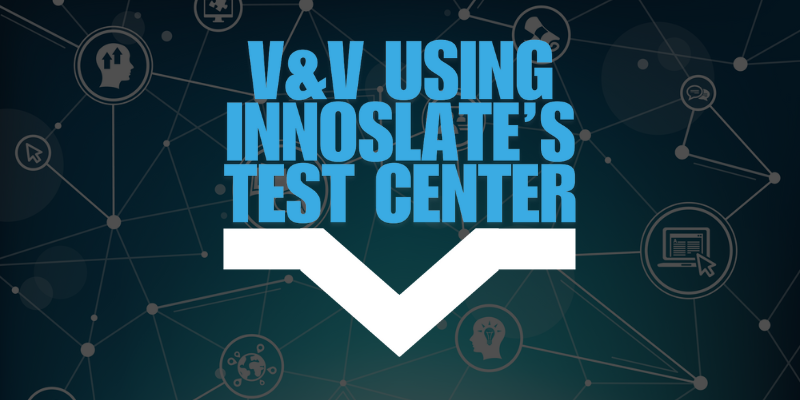V&V Using Innoslate's Test Center Webinar
Want to sit back, relax, and listen? Watch the webinar recording!
7 min read
 John Schatz III
:
6/11/24 2:28 PM
John Schatz III
:
6/11/24 2:28 PM

This guides provides approaches for planning and executing Verification and Validation for Data-Driven Systems Engineering.
Verification and Validation (V&V) are independent evaluation processes for determining a system’s conformance to requirements and suitability for use. V&V occurs on the right side of the Systems Engineering (SE) V as shown in Figure 1-1.
 Figure 1-1. V&V on the Systems Engineering V
Figure 1-1. V&V on the Systems Engineering V
Verification is system focused, proving that the solution was built according to agreed upon specification- level requirements. It shows consistency between design decisions and the assumptions underlying requirements. Verification seeks to answer “Are we building the product right?”1
Verification occurs prior to validation. It is frequently associated with the terms “Unit Test” and “Developmental Test and Evaluation”.
Verification methods are the means by which requirements can be verified. They include:
The verification methods selected must be executable within program constraints (e.g., time, budget, resources).
Validation is operationally focused, proving that solution-independent requirements are satisfied. It addresses stakeholder satisfaction and helps to ensure that the system will ultimately be part of the accepted solution within the target environment. Validation seeks to answer “Are we building the right product?”2
Validation occurs after verification. It is frequently associated with the term “Operational Test and Evaluation”.
Validation methods are the means by which stakeholder satisfaction with the system can be validated. They include:
The validation methods selected must be executable within program constraints (e.g., time, budget, resources).
Test planning involves preparation at multiple levels. This section will discuss different capabilities that Innoslate provides to document, manage, and report on test plans in support of V&V.
Test plans describe the orchestration and intended execution of tests from a program perspective. Test plans should minimally include the following items:
Innoslate implements test plans as Innoslate Documents as shown in Figure 2-1. In Documents View, create a new document with the ‘Test Plan Document’ type. Select a pre-loaded template or enter your own format. Populate the test plan with modeled content as described in Sections 2.1.2 and 2.3.3.
 Figure 2-2. Documents View of Test Plan
Figure 2-2. Documents View of Test Plan
Innoslate provides a range of modeling capabilities that can be used to generate diagrams, charts, and tables for incorporation into a test plan. A summary of potential test plan models is shown in Table 2-1.

Table 2-1. Potential Test Plan Models
A requirement is verifiable when you can “express the expected performance and functional utility so that verification is objective and preferably quantitative”3. In Innoslate, requirements are verified through the execution of Test Cases.
There are two implementation approaches for making a requirement verifiable, as shown in Figure 2-2:
 Figure 2-2. Innoslate Verification Approaches
Figure 2-2. Innoslate Verification Approaches
Verification methods, as described in Section 1.1, should be determined as part of the requirements development process. To specify a requirement’s verification method, add the corresponding Verification Method Label(s) through the Requirement Metadata sidebar as shown in Figure 2-3. For Approach 1, Verification Method Labels are added to Requirement entities. For Approach 2, Verification Method Labels are added to Verification Requirement entities.

Figure 2-3. Verification Method Labels in Sidebar
Requirement verification reports should be run from the verification approach appropriate execution level (i.e., Requirements document for Approach 1, Verification Requirements document for Approach 2), as shown in Figure 2-2.
The Verification Cross Reference Matrix (VCRM) shows the verification method that is associated with each requirement. From within Documents View, filter the document by ‘Only Requirements’. Select ‘Reports’ and report type ‘VCRM Output (XLSX)’. Choose the desired VCRM column options, enter the file name, and select ‘Create’. The VCRM report is shown in Figure 2-4.

Figure 2-4. VCRM Report
The Requirements Verification Traceability Matrix (RVTM) shows the verification method and associated test case(s) for each requirement. From within Documents View, filter the document by ‘Only Requirements’. Select ‘Reports’ and report type ‘RVTM Output (XLSX)’. Choose the desired RVTM column options, enter the file name, and select ‘Create’. The RVTM report is shown in Figure 2-5.

Figure 2-5. RVTM Report
Test management within Innoslate occurs in Test Center. The Test Center Dashboard is used to create and manage Test Suites. A Test Suite is an Artifact entity representing a test event. Separate Test Suites should be created for different V&V events (e.g., Unit Tests, Component Tests, System Tests, Operational Test and Evaluation).
The Test Suite View renders the hierarchical collection of related Test Cases comprising the Test Suite, as shown in Figure 2-6. It supports test management, the visualization of test results, and progress tracking. Test Suite View allows the creation of Test Cycles which persist a snapshot of the cycle’s test results.

Figure 2-6. Test Suite View
Test Cases are tests that occur within a test event. Test Case is a subclass of Action with the additional attributes of Expected Results, Actual Results, Status, and Setup. The Test Case ‘Status’ attribute is visualized and aggregated within the Test Suite View, as shown in Figure 2-7.
 Figure 2-7. Test Case 'Status'
Figure 2-7. Test Case 'Status'
Requirements are verified through the execution of Test Cases. Priority should be given to ensuring that a Test Case’s description, setup information, and expected results are created during V&V planning in coordination with requirement developers.
The Test Cases Output (DOCX) report provides a comprehensive overview of the Test Cases contained within a Test Suite. From within Test Suite View, select ‘Reports’ and report type ‘Test Cases Output (DOCX)’. Choose the desired Test Case attribute options, enter the file name, and select ‘Create’. The Test Cases Output (DOCX) report is shown in Figure 2-8.
 Figure 2-8. Test Cases Output (DOCX) Report
Figure 2-8. Test Cases Output (DOCX) Report
Since Test Cases are a subclass of Action, they can be viewed and manipulated in any diagram available to Actions. Test procedures can be created from a Test Suite’s Test Cases. Test procedure modeling can be used to:
To establish detailed test procedure schedules, first open any decomposed Test Case as an Action Diagram. Then arrange the decomposing child Test Cases to orchestrate the test process. Finally, open the decomposed Test Case as a Timeline Diagram to view and adjust the corresponding test schedule. Figure 2-9 shows a test procedure schedule model.

Figure 2-9. Test Procedure Schedule Model
To estimate test procedure resource utilization and cost, add resource and cost information to the modeled test procedures. Then run a Monte Carlo Simulation from within the test procedure’s Action Diagram.
Expected resource utilization and cost can be determined from the values displayed on simulator panels (e.g., Resource (Radar), Cost Bar Chart, Status) and within simulation reports (e.g., Monte Carlo Resource Report, Monte Carlo Cost Report).
Test execution involves coordinating and running tests. This section will discuss different capabilities that Innoslate provides to facilitate and execute test plans in support of V&V.
The Innoslate project dashboard is the first page displayed when a user accesses a project. Project dashboard widgets can be customized to facilitate V&V by providing testers with situational awareness and one-click access to test resources. Suggested dashboard uses in support of V&V and their corresponding widgets are shown in Table 3-1.
 Table 3-1. Dashboard Uses Supporting V&V
Table 3-1. Dashboard Uses Supporting V&V
For all users to see the customized widgets, a Project Owner should create the dashboard layout. Each widget that is added should have the ‘Save to Project’ switch turned on in its settings. After the customized widgets have been added, the Project Owner should select the ‘Save Dashboard Layout’ button.
Test Cases are executed in accordance with the Test Procedure Schedule. A Test Case’s ‘Actual Results’ and ‘Status’ attributes should be filled in during V&V testing. ‘Status’ values will be rolled-up within the Test Suite hierarchy as shown in Figure 2-7.
Test Cases that are ‘Blocked’ may generate Issue entities. Relate the Test Case with the associated Issue entity using the ‘causes’ relationship.
A Test Suite can be run multiple times. After executing and recording the results for each Test Case within the Test Suite, save the Test Cycle. In the Test Suite View, select ‘More’ and then ‘New Test Cycle.’ Enter a name for the Test Cycle and select ‘Create’. Saving a Test Cycle persists a snapshot of the test results and resets the Test Case statuses to ‘Not Run’. Saved Test Cycles can be selected for viewing on the sidebar’s ‘Test Cycles’ tab.
The TVM Output (XLSX) report provides an overview of a Test Suite’s Test Cases including their corresponding status and verified requirements. In the Test Suite View, select ‘Reports’ and report type, ‘TVM Output (XLSX).’ Choose the desired Test Case attribute options to include ‘Status’, enter the file name, and select ‘Create’. The TVM Output (XLSX) report is shown in Figure 3-1.
 Figure 3-1. TVM Output (XLSC) Report
Figure 3-1. TVM Output (XLSC) Report
Upon test completion, a detailed Test Suite status report can be generated by running the Test Cases Output (DOCX) Report, as described in Section 2.3.2.
Innoslate supports Verification and Validation activities. It provides a versatile toolset for planning, executing, and reporting upon test events.
1 "Verification and Validation: Overview." AcqNotes. March 15, 2024.
https://acqnotes.com/acqnote/careerfields/verification-validation.
2 Larson, Wiley J. Applied Space Systems Engineering. Boston, MA: McGraw-Hill, 2009.

Want to sit back, relax, and listen? Watch the webinar recording!

After watching the movie “Deepwater Horizon” [Deepwater], I observed the catastrophic consequences when critical testing is skipped. The film...
Introduction Recently, a senior US Air Force leader gave a presentation with the slide in Figure 1 showing the challenge areas for continued...